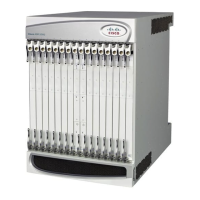ASR 5000 Hardware Platform Overview
ASR 5000 Application Cards ▀
Cisco ASR 5000 Series Product Overview ▄
Packet Services Card 2 (PSC2) Description
The Packet Services Card 2 (PSC2) is the next-generation packet forwarding card for the ASR 5000. The PSC2 provides
increased aggregate throughput and performance, and a higher number of subscriber sessions.
The PSC2 has been enhanced with a faster network processor unit, featuring two quad-core x86 2.5Ghz CPUs, 32 GB of
RAM. These processors run a single copy of the operating system and appear as a single CPU in the
command (CPU0). The operating system running on the PSC treats the two dual-core processors as a 4-way
multi-processor. You can see this in the output of the command.
The PSC2 provides 2 to 2.7 times the data throughput of the original PSC, and the switch fabric interface has been
doubled. A second-generation data transport fixed programmable gate array (DT2 FPGA, abbreviated as DT2) connects
the PSC2‘s NPU bus to the switch fabric interface. The FPGA also provides a bypass path between the line card or
Redundancy Crossbar Card (RCC) and the switch fabric for ATM traffic. Traffic from the line cards or the RCC is
received over the FPGA‘s serial links and is sent to the NPU on its switch fabric interface. The traffic destined for the
line cards or RCC is diverted from the NPU interface and sent over the serial links.
DT2 FPGA also connects to the control processors subsystem via a PCI-E bus. The PCI-E interface allows the control
processors to perform register accesses to the FPGA and some components attached to it, and also allows DMA
operations between the NPU and the control processors‘ memory. A statistics engine is provided in the FPGA. Two
reduced latency DRAM (RLDRAM) chips attached to the FPGA provide 64MB of storage for counters.
The PSC2 has a 2.5 G/bps-based security processor that provides the highest performance for cryptographic acceleration
of next-generation IP Security (IPsec), Secure Sockets Layer (SSL) and wireless LAN/WAN security applications with
the latest security algorithms.
Interoperability
It is not recommended that you mix PSC2s with PSCs or PPCs, since this prevents the PSC2 from operating at its full
potential. Due to the different processor speeds and memory configurations, the PSC2 cannot be combined in a chassis
with PSCs or PPCs.
The system will reduce the performance of the PSC2 to that of a PSC or PPC if either of those cards are in the system.
This is due to the different performance and switch fabric configuration. A system booting up with mixed cards will
default to the slower performance mode. A PSC or PPC added to a running PSC2 system will be taken offline. A PSC2
added to a running PSC or PPC system will start up in this slower mode.
The PSC2 is capable of dynamically adjusting the line card connection mode to support switching between XGLCs and
non-XGLCs with minimal service interruption.
Redundancy
PSC2 is fully redundant with a spare PSC2.
PSC2 is redundant with PSC, as long as there is no IPSec and the PSC2 is operating in the compatibility mode.
ICSR is not supported between a chassis using PSC2s and a chassis using PSCs or PPCs due to the different
capabilities of the two chassis.

